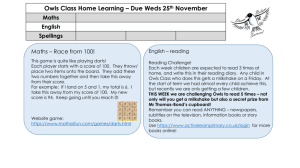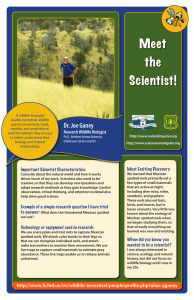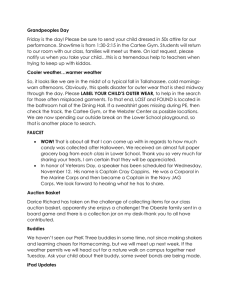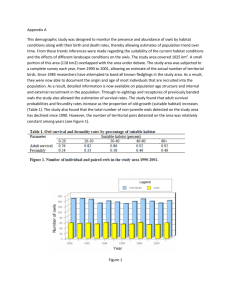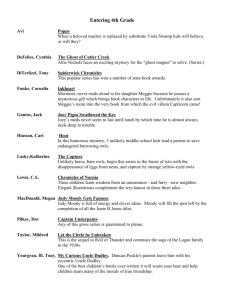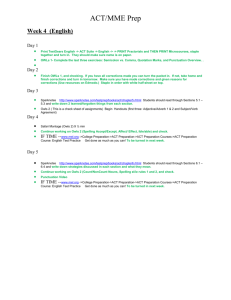SURVIVAL AND REPRODUCTION OF RADIO-MARKED ADULT SPOTTED OWLS
advertisement
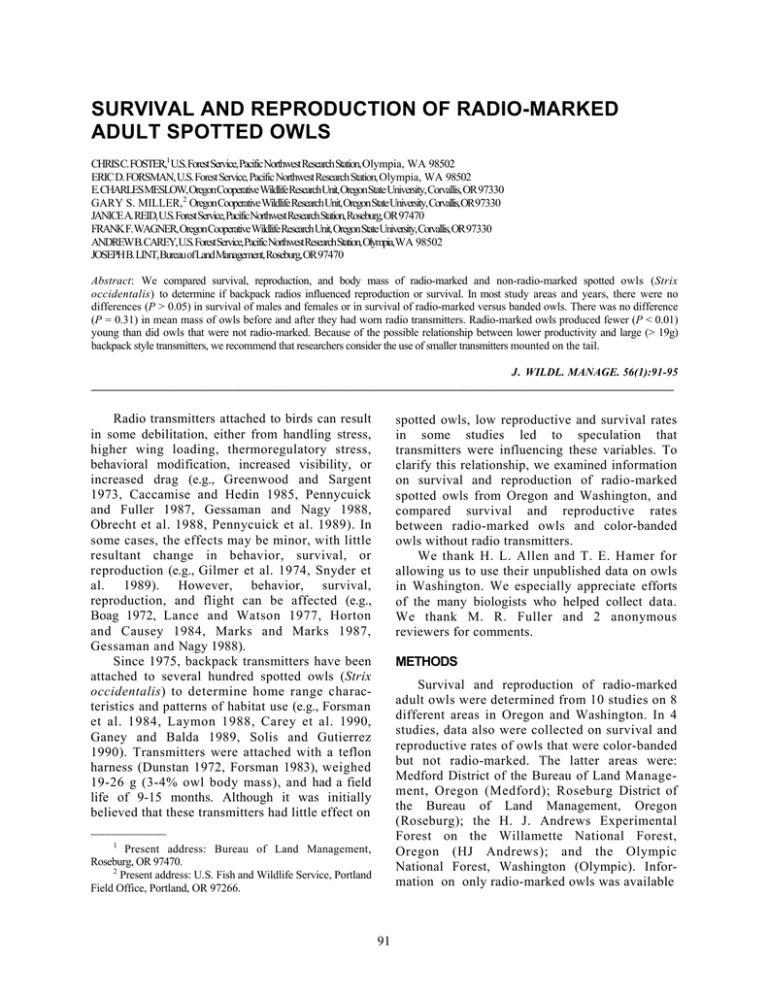
SURVIVAL AND REPRODUCTION OF RADIO-MARKED ADULT SPOTTED OWLS CHRIS C. FOSTER,1 U.S. Forest Service, Pacific Northwest Research Station, Olympia, WA 98502 ERIC D. FORSMAN, U.S. Forest Service, Pacific Northwest Research Station, Olympia, WA 98502 E.CHARLES MESLOW,OregonCooperativeWildlifeResearchUnit,OregonState University, Corvallis, OR 97330 GARY S. MILLER,2 Oregon Cooperative Wildlife Research Unit, Oregon State University, Corvallis,OR97330 JANICEA. REID, U.S.Forest Service,PacificNorthwestResearch Station, Roseburg, OR 97470 FRANK F. WAGNER, Oregon Cooperative Wildlife Research Unit, Oregon State University, Corvallis, OR 97330 ANDREWB.CAREY,U.S.ForestService,PacificNorthwestResearchStation,Olympia,WA 98502 JOSEPH B. LINT, Bureau of Land Management, Roseburg, OR 97470 Abstract: We compared survival, reproduction, and body mass of radio-marked and non-radio-marked spotted owls (Strix occidentalis) to determine if backpack radios influenced reproduction or survival. In most study areas and years, there were no differences (P > 0.05) in survival of males and females or in survival of radio-marked versus banded owls. There was no difference (P = 0.31) in mean mass of owls before and after they had worn radio transmitters. Radio-marked owls produced fewer (P < 0.01) young than did owls that were not radio-marked. Because of the possible relationship between lower productivity and large (> 19g) backpack style transmitters, we recommend that researchers consider the use of smaller transmitters mounted on the tail. J. WILDL. MANAGE. 56(1):91-95 ______________________________________________________________________________________________________ Radio transmitters attached to birds can result in some debilitation, either from handling stress, higher wing loading, thermoregulatory stress, behavioral modification, increased visibility, or increased drag (e.g., Greenwood and Sargent 1973, Caccamise and Hedin 1985, Pennycuick and Fuller 1987, Gessaman and Nagy 1988, Obrecht et al. 1988, Pennycuick et al. 1989). In some cases, the effects may be minor, with little resultant change in behavior, survival, or reproduction (e.g., Gilmer et al. 1974, Snyder et al. 1989). However, behavior, survival, reproduction, and flight can be affected (e.g., Boag 1972, Lance and Watson 1977, Horton and Causey 1984, Marks and Marks 1987, Gessaman and Nagy 1988). Since 1975, backpack transmitters have been attached to several hundred spotted owls (Strix occidentalis) to determine home range characteristics and patterns of habitat use (e.g., Forsman et al. 1984, Laymon 1988, Carey et al. 1990, Ganey and Balda 1989, Solis and Gutierrez 1990). Transmitters were attached with a teflon harness (Dunstan 1972, Forsman 1983), weighed 19-26 g (3-4% owl body mass), and had a field life of 9-15 months. Although it was initially believed that these transmitters had little effect on ___________ spotted owls, low reproductive and survival rates in some studies led to speculation that transmitters were influencing these variables. To clarify this relationship, we examined information on survival and reproduction of radio-marked spotted owls from Oregon and Washington, and compared survival and reproductive rates between radio-marked owls and color-banded owls without radio transmitters. We thank H. L. Allen and T. E. Hamer for allowing us to use their unpublished data on owls in Washington. We especially appreciate efforts of the many biologists who helped collect data. We thank M. R. Fuller and 2 anonymous reviewers for comments. METHODS Survival and reproduction of radio-marked adult owls were determined from 10 studies on 8 different areas in Oregon and Washington. In 4 studies, data also were collected on survival and reproductive rates of owls that were color-banded but not radio-marked. The latter areas were: Medford District of the Bureau of Land Management, Oregon (Medford); Roseburg District of the Bureau of Land Management, Oregon (Roseburg); the H. J. Andrews Experimental Forest on the Willamette National Forest, Oregon (HJ Andrews); and the Olympic National Forest, Washington (Olympic). Information on only radio-marked owls was available 1 Present address: Bureau of Land Management, Roseburg, OR 97470. 2 Present address: U.S. Fish and Wildlife Service, Portland Field Office, Portland, OR 97266. 91 92 RADIO TRANSMITTERS ON SPOTTED OWLS • Foster et al. from the Eugene District, Bureau of Land Management, Oregon; Cle Elum Ranger District, Wenatchee National Forest, Washington; Mt. Baker Ranger District, Mt. Baker-Snoqualmie National Forest, Washington (T. E. Hamer, Mt. Vernon, Wash., unpubl. data); and locations scattered throughout western Washington (H. L. Allen, Washington Department of Wildlife, unpubl. data). In addition to a U.S. Fish and Wildlife Service leg band, all owls were fitted with either a backpack style transmitter, a colored leg band, or both. Backpack harnesses were constructed of 7-mm-wide tubular teflon ribbon molded to the transmitter. The body and neck loops were either sewn or crimped (metal crimp) together over the upper sternum (Dunstan 1972, Forsman 1983). Most studies used model P1 or P2 transmitters (19-22 g with harness, AVM Instrument Company, Livermore, CA). Exceptions were the WDW study (model RB-5 transmitters, 26-29 g with harness, Telonics Telemetry-Electronics Consultants, Mesa, Ariz.), and the 1975 HJ Andrews and 1980 Eugene BLM studies (U.S. Fish and Wildlife Service transmitters, 21-23 g with harness). Studies were conducted by many individuals with varying amounts of experience in trapping and handling birds. Although there was variation among researchers, all owls were trapped and handled using similar techniques (Forsman 1983). Owls that were radio-marked were handled 25-30 minutes longer than birds that were color-banded. Color-banded owls usually were trapped only once, whereas radio-marked birds were trapped up to 6 times to replace transmitters. Owls were classified as adults if they had mottled tips on their rectrices as opposed to the clear white tips characteristic of subadults (Forsman 1981). We divided owls into 2 groups for comparison of survival and reproductive rates, those that were only color-banded and those that were radiomarked or radio-marked and color-banded. We calculated annual survival rates (1 Mar-28 Feb) for radio-marked owls using program Micromort (Heisey and Fuller 1985). For samples in which owls were observed for at least a year, we also calculated empirical annual survival rates by dividing the number of owls radio-marked during each breeding season (1 Mar-31 Aug) by the number alive in the following breeding season. Survival rates for color-banded owls were calculated using the empirical method only because program Micromort is appropriate only for animals that are monitored continuously. J. Wildl. Manage. 56(1):1992 Estimates of survival using Jolly-Seber models would have been preferable to the empirical approach, but were not possible because sampling periods were, in most cases, less than the minimum 3 complete annual samples required for Jolly-Seber estimates. Comparisons of survival rates within the radio-marked group were made using a Z-test (Heisey and Fuller 1985). We compared empirical survival rates within the color-banded group or between color-banded and radio-marked groups using Fishers Exact Test when the number of cases was <30, or a Chi-square test when the number of cases was ≥30 (Norusis 1988). We used Sign tests to determine if survival or reproductive rates differed for the entire sample of color-banded and radio marked owls. We compared the mean number of young fledged by radio-marked and color-banded owls with a pooled variance t-test for samples with homogenous variances, and a separate variance t-test for samples with unequal variances (Zar 1984). Samples were grouped by pairs in which I or both adults were radiomarked by at least 1 April, or pairs in which neither adult was radio-marked. We compared survival and reproductive rates of radio-marked and color-banded owls only for samples collected in the same study area and year(s). Pooling of samples collected in different locations or years was avoided because we did not want to confound the analysis with regional or annual variation in survival and reproduction (Forsman et al. 1984, Thomas et al. 1990). We used paired ttests to compare differences in live mass of owls between initial capture and subsequent captures. RESULTS Survival When sexes were combined, empirical survival rates of radio-marked and color-banded owls differed in 1 of 11 comparisons, that being the Medford Study area in 1986-87 (Table 1). When survival rates of radio-marked and colorbanded owls were compared separately by sex, there were no differences in any year or study area (all P’s ≥ 0.05). Sign tests of empirical survival rates indicated there were no differences between radio-marked and color-banded birds, either for the combined sample (P = 0.75), or for males (P = 1.0) or females (P = 0.75). Body mass of owls before and after they had worn radio transmitters did not differ for males (n = 52, t = 0.52, P = 0.60) or females (n = 62, t = 1.61, P = 0.11). J. Wildl. Manage. 56(1): 1992 RADIO TRANSMITTERS ON SPOTTED OWLS • Foster et al. 93 Survival rates of radio-marked males and females differed in 5 of 29 comparisons (Table 2). Of the 5 instances where survival rates differed, male survival was higher in 3 cases and lower in 2 cases (Table 2). There was no trend towards differential survival of males and females in either the radio-marked (P = 0.83) or color-banded (P = 1.00) samples. Mortality Forty-six mortalities of radio-marked individuals were reported (20 M, 26 F). Mortality factors, in order of frequency, were: unknown (n = 22), avian predation (15), starvation/emaciation (3), transmitter-caused (3), hit by car (2), shooting (1). Two deaths caused by transmitters occurred when owls became entangled in the transmitter harness, and 1 owl died from subcutaneous abrasions inflicted by the harness. Sixteen owls that were retrapped to remove or replace transmitters had abrasions under the transmitter or harness, and in 3 cases, abrasions were believed to be life-threatening. Most abrasions appeared to be caused by transmitter packages that were too tight or too loose. Reproduction In 4 of 11 cases, the number of young fledged by radio-marked owls was lower than for color-banded owls (Table 3). Although 7 comparisons indicated no statistically significant differences, a comparison of the entire sample indicated that radio-marked owls produced fewer young than color-banded owls (P = 0.008), and the trend in all but 1 case was for lower productivity in radio-marked birds (Table 3). DISCUSSION Depending upon the type of package, a transmitter is likely to have at least some effect on agility and flight (Aldridge and Brigham 1988, Pennycuick and Fuller 1987). In addition, many animals, when first radio-marked, go through a period of behavioral adjustment, during which they may be distracted by the transmitter and may therefore be more susceptible to predation or negative energy balance (e.g., Marks and Marks 1987). These factors are likely to affect spotted owls marked with backpack transmitters. However, our results indicate that any debilitating effects caused by 19- to 26-g back packs were not serious enough to influence survival of adult spotted owls, as long as the transmitter was installed correctly. Because of the presumably higher wing loading of female spotted owls (Earhart and Johnson 1970), it could be predicted that females should be more 94 RADIO TRANSMITTERS ON SPOTTED OWLS • Foster et al. affected by a given transmitter load than males. Our data indicate that the additional stress caused by 19- to 26-g backpack transmitters was not great enough to create consistent differences in survival of male and female spotted owls. Spotted owls are relatively slow fliers, rarely make long distance flights, and regularly carry heavy prey to their nests. In most areas their diet is dominated by flying squirrels and woodrats with body masses ranging from 100-350 g (17-64% of owl body mass) (Barrows 1980, Forsman et al. 1984). For a bird with these life history traits, the aerodynamic drag created by the transmitter is probably inconsequential compared to the additional transmitter mass that the bird must carry (Pennycuick et al. 1989). A 19- to 29-g transmitter could reduce the amount of prey that could be carried by males (Pennycuick et al. 1989), resulting in less prey being delivered to nesting females or young. This could contribute to the trend toward lower numbers of young produced by radiomarked spotted owls. Abrasions caused by backpack harnesses suggest that the harness and transmitter may be a considerable irritant if fitted incorrectly. This may not kill the bird, but may affect behavior and balance. Differences in installation technique could account for some of the variation in survival and reproductive rates among and within studies, but we could not verify this because comparisons of survival and reproductive rates in different studies were confounded by differences in years and areas. Studies have suggested that radio-marked birds may be more susceptible to predation than unmarked J. Wildl. Manage. 56(1):1992 birds (Marks and Marks 1987, Amstrup 1980). Although avian predation was a major source of mortality of radio-marked spotted owls, there was no evidence that this was unusual. If it had been, we should have seen lower survival in radio-marked birds than in banded birds. It is possible that relationships between backpack transmitters, survival rates, and reproductive output were obscured by differences in detectability of radio-marked and color-banded owls. For example, it is relatively easy to document nesting status and numbers of young produced by radio-marked pairs. By comparison, color-banded pairs tend to be more difficult to locate, especially when they are not nesting. Thus, it is likely that nesting pairs of colorbanded owls are overrepresented in samples, producing an inflated estimate of the average number of young produced per pair. We could not evaluate the size of this bias. We also could not discount the possibility that empirical survival estimates of color-banded owls underestimate the actual survival rate because some birds that are alive go undetected. This could result in an underestimate of differences in survival of radio-marked and colorbanded owls. Although the individual comparisons were not always statistically significant, the well-defined trend towards lower reproductive performance in radio-marked owls should be cause for concern. Until the above biases are better understood, results of our analysis should be viewed as cautionary by researchers contemplating use of backpack transmitters on spotted owls. Smaller transmitters mounted on the tail feathers may be considered as an alternative. LITERATURE CITED Aldridge, H. D. J. N., AND R. M. BRIGHAM. 1988. Load carrying and maneuverability in an insectivorous bat: a test of the 5% “rule” of radio-telemetry. J. Mammal. 69:379382. AMSTRUP, S. C. 1980. A radio collar for game birds. J. Wildl. Manage. 44:214-217. BARROWS, C. 1980. Feeding ecology of the spotted owl in California. Raptor Res. 14:73-78. BOAG, D. A. 1972. Effect of radio packages on behavior of captive red grouse. J. Wildl. Manage. 36:511-518. CACCAMISE, D. F., AND R. S. HEDIN. 1985. An aerodynamic basis for selecting transmitter loads in birds. Wilson Bull. 97:306-318. CAREY, A. B., J. A. REID, AND S. P. HORTON. 1990. Spotted owl home range and habitat use in southern Oregon coast ranges. J. Wildl. Manage. 54: 1117. J. Wildl. Manage. 56(1): 1992 RADIO TRANSMITTERS ON SPOTTED OWLS • Foster et al. DUNSTAN, T. C. 1972. Radio-tagging falconiform and strigiform birds. Raptor Res. 6:93-102. EARHART, C. M., AND N. K. JOHNSON. 1970. Size dimorphism and food habits of North American owls. Condor 72:251-264. FORSMAN, E. D. 1981. Molt of the spotted owl. Auk 98:735-7-12. _____. 1983. Methods and materials for locating and studying spotted owls. USDA For. Serv. Pac. Northwest For. and Range. Exp. Stn. Gen. Tech. Rep. PNW-162. 8pp. _____, E. C. MESLOW, AND H. M. WIGHT. 1984. Distribution and biology of lice spotted owl in Oregon. Wild I. Monogr. 87. 64pp. GANEY, J. L., AND R. P. BALDA. 1989. Home-range characteristics of spotted owls in northern Arizona. J. Wild1. Manage. 53:11591165. GESSANAN, J. A., AND K. A. NAGY. 1988. Transmitter loads affect the flight speed and metabolism of homing pigeons. Condor 90:662668. GILMER, D. S., I. J. BALL, L. M. COWARDIN, AND J. H. RIECHMANN. 1974. Effects of radio packages on wild ducks. J. Wildl. Manage. 38:243-252. GREENWOOD, R. J., AND A. B. SARGENT. 1973. Influence of radio packs on captive mallards and blue-winged teal. J. Wildl. Manage. 37:3-9. HEISEY, D. M., AND T. K. FULLER. 1985. Evaluation of survival and cause-specific mortality rates casing telemetry data. J. Wildl. Manage. 49:668-674. HURTON, G. I., AND M. K. CAUSEY. 1984. Brood abandonment by radio-tagged American woodcock hens. J. Wildl. Manage. 48:606607. LANCE, A. N., AND A. WATSON. 1977. Further tests of radio-marking on red grouse. J. Wildl. Manage. 41:579-582. 95 LAYMON, S. D. 1988. The ecology of the spotted owl in the central Sierra Nevada, California. Ph.D. Thesis, Univ. California, Berkeley. 285pp. MARKS, J. S., AND V. S. M.ARKS. 1987. Influence of radio collars on survival of sharp-tailed grouse. J. Wildl. Manage. 51:468-471. NORUŠIS, M. J. 1988. The SPSS guide to data analysis for SPSS/PC +. SPSS Inc., Chicago, Ill. 434pp. OBRECHT, H. H., III., C. J. PENNYCUICK, AND M . R. FULLER. 1988. Wind tunnel expel intents to assess the effect of back-mounted radio transmitters on bird body drag. J. Exp. Biol. 135:265-273. PENNYCUIlCK, C. J., AND M. R. FULLER. 1987. Considerations of effects of radio-transmitters on bird flight. Proc Int. Symp. on Biotelemetry 9:327-330. _____, M. R. FULLER, AND L. M C ALLISTER. 1989. Climbing performance of Harris hawks (Parabuteo unicinctus) with added load: implications for muscle mechanics and for radiotracking. J. Exp. Biol. 142:17-29. SNYDER, N. F. R., S. R.. Beissinger, AND M. R. FULLER. 1989. Solar radio-transmitters on snail kites in Florida. J. Field Ornithol. 60:171-177. SOLIS, D. M., AND R. J. GUTIERREZ. 1990. Summer habitat ecology of northern spotted owls in northwestern California. Condor 92:739-748. THOMAS, J. W., E. D. FORSMAN, J. B. LINT, E. C. MESLOW, B. B. NOON, AND J. VERNER. 1990. A conservation strategy for the northern spotted owl. USDA For. Serv., Portland, Oreg. 427pp. ZAR, J. H. 1984. Biostatistical analysis. Second ed. Prentice-Hall, Inc., Edgewood, N.J. 718pp. Received 4 June 1990. Accepted 23 July 1991. Associate Editor: Smith.


